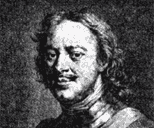| |||
Introducing St. Petersburg, Russia
History Overview
Where he first set foot on the Baltic coast, legend has it, Peter the Great proclaimed: "Here there shall be a town." And so on Hare Island on May 16, 1703, workers laid the foundation for the Peter and Paul Fortress, his bastion against the Swedes. The city of St. Petersburg soon spread across the Neva delta. It replaced Moscow as Russia's capital in 1712.
A traveler in his youth, Russia's great westernizer was determined that his new capital imitate the imposing seaports of London and Amsterdam, which were familiar to him from his brief stints as a shipwright. Only an autocrat and visionary could have built such a city, and neither Sweden nor a reluctant court in Moscow could stand in his way as he dragged Russia, a backward giant, into the modern world. At prodigious cost to the imperial treasury, a city more European than Russian thus rose from the Baltic swamps.
The city's architecture, administration and social life were all copied or imported; while the splendid buildings were alien to indigenous forms and out of place in the surrounding countryside. Artificiality and self-consciousness were present from the beginning and this showpiece city of palaces and canals soon decreed itself the arbiter of Russia's sensibility and imagination. Pelersburgers still tend to look down on the earthier Muscovites, who regard them in turn as snobbish. As the last Tsar, Nicholas II, once remarked, "Remember, St Petersburg is Russian - but it is not Russia".
Today Peter's legacy is everywhere: in the wealth of baroque and neoclassic architecture; in the dozens of research centers famous for discoveries in chemistry, genetics, psychology, and space sciences; and in the shipyards that once equipped the Soviet Navy for nuclear con-frontation with the West. Accessible year-round, the harbor links "Peter," as its five million inhabitants call the city, to the open sea.
During World War I, Tsar Nicholas II Russified the city's name, changing it to Petrograd, or City of Peter. But a name change could not mask the bankruptcy of the Romanov dynasty, which was toppled by revolution in 1917. In 1924, following the death of Lenin, the Soviets - who had returned the government to Moscow-changed the name again, to honor the Bolshevik leader. The name Leningrad lasted until 1991, when the new Russian Parliament quietly approved the city's petition to resume its historic name.
Next | Main Page | Our Service | Mail Us

Peter the Great, founder of the city